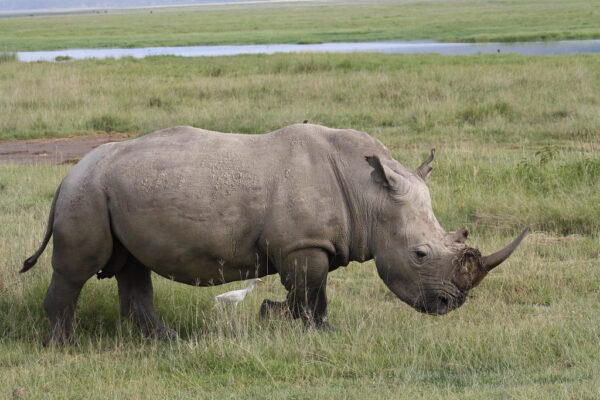The white rhinoceros (Ceratotherium simum) is the largest extant species of rhinoceros and one of the world’s most iconic animals. It is native to southern Africa, where it inhabits grasslands and savannas. It has two distinct subspecies: the southern white rhinoceros (Ceratotherium simum simum) and the northern white rhinoceros (Ceratotherium simum cottoni).
Physical Traits
White rhinos are large, stocky animals with distinctive square-shaped lips. They have thick, grey skin and a short, sparse hair coat. Adult males can reach 1.85m in height and weigh up to 3.6 tonnes. Females are slightly smaller than males and typically weigh between 1,000 and 2,000 kg.
Life Span
White rhinos can live for up to 40 years in the wild or longer in captivity.
Habitat
White rhinos inhabit grasslands and savannas in southern Africa. They prefer areas with plenty of water sources, such as rivers, lakes, swamps, or mud wallows.
Diet
White rhinos are pure grazers that feed on grasses and other low-lying vegetation such as leaves, twigs, bark, and fruit when available. They can consume up to 150kg of vegetation per day!
Reproduction
Mating season for white rhinos occurs during the wet season when food is plentiful. Gestation takes approximately 16 months, after which a single calf is born weighing around 45 kg. The calf will stay with its mother until it reaches sexual maturity at about 5 years old for females and 7 years old for males.
Conservation Status
The white rhino is listed as Near Threatened by the IUCN Red List due to poaching for their horns which are highly valued in traditional Chinese medicine markets despite having no medicinal value whatsoever! There are currently an estimated 18,000-20,000 individuals left in the wild. Still, populations continue to decline due to poaching pressure, so conservation efforts must be increased to save this species from extinction!
Interesting Facts
- White rhinos are grey! Their name comes from an Afrikaans word, “weit” which means wide and refers to their square-shaped lip used for grazing on grasses.
- White rhinos have poor eyesight but excellent hearing, so they rely heavily on their sense of smell to detect predators, such as lions or hyenas, who may lurk nearby!
- White rhinos are very social; they often form groups called ‘crashes’ consisting of several females led by one dominant male who defends his harem from other males looking to mate with them!


